Horses have sex doggy-style. Cows have sex doggy-style. Cats have sex doggy-style. Isn’t there something kind of messed up about that? Why do dogs — one of many, many animals that primarily enjoy a mounting-from-behind position when copulating — get the naming rights?
It isn’t just limited to English speakers either. In French, it’s faire l’amour en levrette — “doing love like a greyhound,” while an archaic French expression referring to sex in general is faire la danse du loup, or “doing the wolf dance.” In Polish, it’s na pieska, or “the dog.” Meanwhile, some Spanish speakers will opt for el perrito, or “the puppy.”
In fairness, some languages do go for other animals. In Russian, it’s rakom, “like a crab.” In Romanian, it’s capra (“the goat”). In Italian, it’s a pecora (“like a sheep”), while in Thai, it’s kwang lio lang (“like a deer looking back”). There are, of course, more colorful euphemisms — one Cantonese expression (老漢推車) roughly translates to “an old man pushing a cart” — and very unimaginative ones (like the Finnish takaapäin, which just means “from behind”).
But dogs certainly seem to have the majority share of references. What in the hell is going on with that — more importantly, is it even accurate?
When humans have sex from behind, it might superficially resemble what a pair of horny dogs would do, but when it comes to the specifics of what’s going where and how, it’s pretty different. Penetration takes place with the male dog’s penis flaccid, guided in by the baculum, or penis bone. This, obviously, isn’t how the human body works.
Then there’s knotting. “Canids form a knot,” says Daniella Rabaiotti of the Zoological Society of London. “The penis latches inside the vagina using penile spines so they can, like, walk around stuck together.”
Spiky, floppy dog dicks forming knots — this isn’t the typical experience of people engaged in doggy-style sex. So then, why still bring dogs into it?
“I’d imagine it got the name because it was just the animal that people saw most often,” says Carin Bondar, biologist and author of Wild Sex: The Science Behind Mating in the Animal Kingdom. “Dogs certainly copulate a lot, but that’s because there are also social signals that can be gained from sexual advances.” For instance, among other things, dogs can use sex to assert dominance.
Rabaiotti agrees. “I feel like there must be a definitive answer to this,” she says. “But my expert opinion is just, people spend a lot of time around dogs.” Rabaiotti works extensively with African wild dogs, and confirms that not only do non-domesticated dogs perform in the same way as domestic canines, they do it a lot: “They hump everything, everywhere, so you see it a lot, unlike cats which have far too much poise.”
Which raises another point — perhaps dogs are, as domestic animals go, that much more animally than others. Mice have sex in the same way as dogs, but as a phrase, “mouse-style” has a timidity to it while “doggy-style” sounds both wild and, thanks to the cuteness of “doggy” rather than “dog,” playful.
Not a lot of animals have a doggy-esque nickname either. Horsey-style is out because of horses’ role as the large-penis go-to of the animal kingdom. Kitty is out for a couple of reasons: 1) being derived from “kitten” rather than “cat,” introducing an unwelcome and unpleasant juvenile element; and 2) sounding like “kiddy” which for obvious reasons is strikingly inappropriate. Piggy-style sex is very, very funny as a phrase but not exactly… hot?
Dogs, on the other hand, are seen as loyal, lovable and dependable. There’s a balance at play with “doggy-style” — again, between animalistic wildness and cuddly friendliness. It’s great branding. Or better put given the topic at hand, they have a remarkable style.

